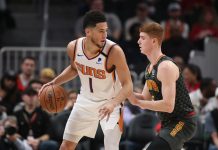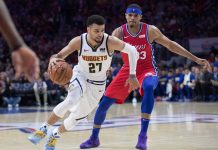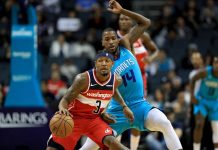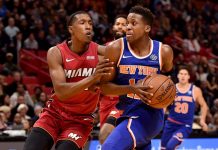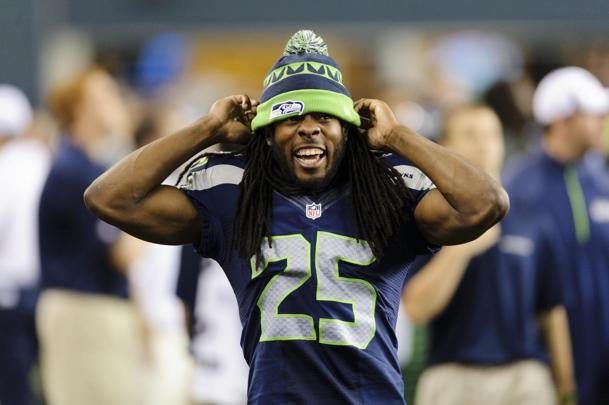OAKLAND, Calif. (AP) When Stephen Curry’s shot needs a little something, he dives into ”The Menu.” Warriors teammate Klay Thompson might put up a few extra shots after an off night. If Kevin Durant is trying to rediscover his rhythm, he does some studying that usually means watching his made shots.
Golden State boasts some of the world’s best shooters and each has his own way of bouncing back from a poor performance.
For Curry, there is no actual list or book for ”The Menu.” The two-time MVP and his right-hand shooting man, Bruce Fraser, keep all the details in their heads for what the record-breaking 3-point sharpshooter could use work on any given day. It comes in especially handy when the shots aren’t falling, though Curry certainly found his touch fast in returning from nearly six weeks on the sidelines with a knee injury to score 28 points in a Game 2 win against New Orleans on Tuesday night. Golden State leads the series 2-0 going into Friday.
Maybe Curry needs more catch and shoots one day. Or off-the-dribble work. Sometimes, it’s ballhandling into his shot. Perhaps a look at balance, rhythm and core, or just focusing on spot shooting from various places.
”We collaborate. It’s like going to dinner with your wife, maybe. Maybe some people’s wives tell them what they want,” said Fraser, a Warriors player development coach. ”Different restaurant, different menu. We have a lot of things to pull from and it’s usually based one day, need. What does Steph need that day? … The Menu has all sorts of creative pieces in it that get the workout you want. Sometimes we’ll piece things together and go a la carte, sometimes we’ll make it a simple meal. I’m kind of having fun with it.”
On the opposite end of the defending champions’ practice floor, Thompson’s shooting plan might be nearly as precise as he works back from a bad night – he went 4 for 20 and 2 of 11 on 3s Tuesday. Thompson will usually put up a few extra shots after a poor performance. Depending largely on how he feels physically, he might take as few as 50 shots, or well more than 200.
Either way, it typically doesn’t take Thompson long to feel right again.
The belief Thompson has in his shooting ability is unwavering and he ignores any critics when it comes to his shot, considering they aren’t ”in the gym with me shooting every day.”
”I will never doubt myself when it comes to shooting. I put too much effort into it,” he said, adding, ”I know what it takes.”
In a Game 4 loss to San Antonio in the Warriors’ first-round series, Thompson finished 4 for 16 and scored 12 points. He was 42 of 71 – 59.2 percent – over the other four games against the Spurs.
”They make up for the bad shooting nights on the days before the bad shooting nights. They can’t get out of it by going into the gym and just shooting,” said Chris Webber, a TNT analyst who played 15 NBA seasons. ”They’re great shooters and all the thousands of shots they’ve been taking since college is what makes them bounce back.”
Webber believes coach Steve Kerr’s offensive system allows players to keep shooting and break out of ruts.
”Knowing where you’re going to get your shots, how you’re going to get your shots, and you have the freedom,” Webber said, ”but it’s all because of how hard and how many shots they take and put in the work when no one’s looking.”
After that Game 4 against the Spurs, Thompson took a heavy shooting day.
”Probably a couple hundred, nothing serious,” he said matter-of-factly.
Kerr, a talented 3-point shooter in his own right, considers the psychological component to the process as well.
”Sometimes the best thing to do if you have a bad game is to not shoot,” he said. ”And you have to feel that, and as a player once you’ve been in the league a few years you get it. You start to understand, `OK, maybe I feel a little tired so I’m going to go walk Rocco (Thompson’s bulldog) today instead down at the park and enjoy some sunshine. Or go play golf or something. Or there’s a mechanical flaw and it’s almost like a golfer, you go to the range and you go, `I’ve got to find it.’
”But as a player you figure it out and the more years you’ve played in the league the easier it is to tell what the right approach is.”
After an off-night, Durant mentally goes back through each possession and studies his shots – ”mainly my makes.”
Curry constantly changes his workload and regimen. Durant notes, ”it takes a lot to shoot a basketball … there’s a lot you’ve got to think about in a couple of seconds.”
After most practices starting during last year’s title run, Curry and Durant engage in good-natured shooting contests from all over the court . They regularly take 10 shots from different spots, keeping track of who hits more. They’re usually very close.
”It’s a feel thing. You monitor your fatigue level because during the season, 82 games, there’s gaps in the schedule where you can go a little harder,” Curry said. ”Back-to-backs obviously you can’t. Me and Q come up with, we call it `The Menu.’ I walk over, open up the fake menu, read down the list and see what type of workout we need. He usually tries to come up with on a scale from 1 to 10 like a 2, a 4, a 6, 8-type of workout. We go that way. There’s never really a set kind of regiment to it.
”I have certain drills I like and I know help me in certain different facets of the game. But beyond that it’s kind of unpredictable and I like it because you don’t really know what to expect on every single day.”
It comes down to a specific routine, and each shooter has his own.
For Curry, he is usually 99 percent in charge and Fraser said he offers about 1 percent input.
”There’s reason to it all,” Fraser said. ”It depends on how he’s missing, if he’s missing. And Steph doesn’t miss too much. It’s not just based on, `Oh, you’re missing.’ Are you missing because you’re off balance? Are you missing because you’re not getting your body into it? Why are you missing? … They’re all human so they’re going to miss.”
Then, it’s back to ”The Menu.”
—
More AP NBA: https://apnews.com/tag/NBAbasketball
25% Bonus via Western Union


